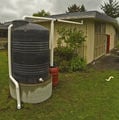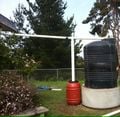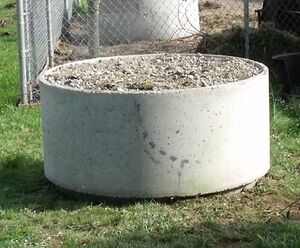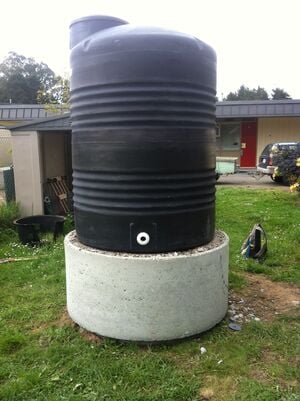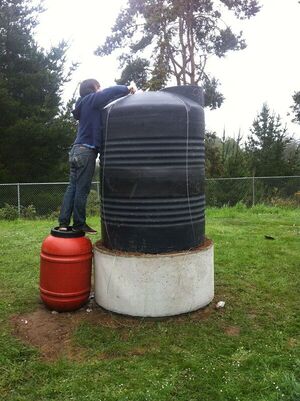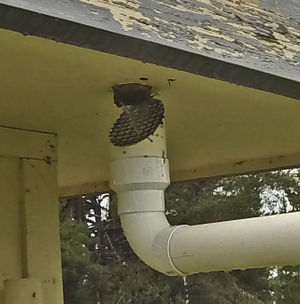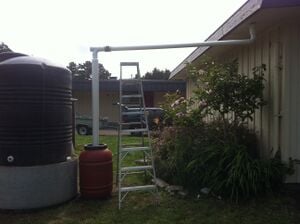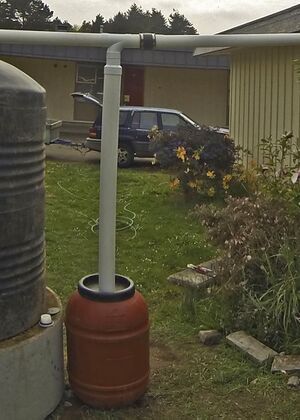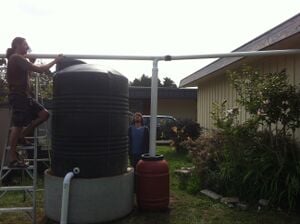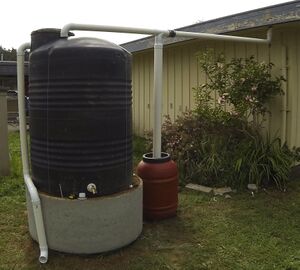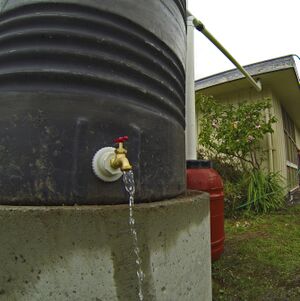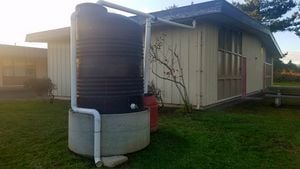
After hearing about some issues that Zane Middle School needed help addressing, Team Rain Catchers (Chip Brocious, Charles Diehl, Hannah Marsh, and Amanda Norton) came together with a plan on designing and building a solution that would help to collect and store water for use in the school's garden. Zane middle school set forth some criteria as guidelines to follow. A rainwater catchment system has been successfully designed and is now being implemented on Zane's campus. The next step to follow will be to teach the students how to use the Rainwater Catchment System.
Background[edit | edit source]
Cal Poly Humboldt has partnered with Zane Middle School in Eureka, California for the Engr205 Introduction to Design class project. Zane is currently the only Middle School in Eureka and accommodates over six hundred students. Its unique STEAM (Science, Technology, Engineering, Art, and Math) program, integrates hands on experiences with Science, Technology, Engineering, Art and Math into everyday curriculum. This unique program not only fosters critical thinking and problem solving skills, but also inspires students to think about their future.
-
Zane Middle School garden still growing in 2016. Rainwater catchment in the background provides the water.
-
Problem statement and criteria[edit | edit source]
The objective is to design a rainwater catchment system on Zane's campus. The water catchment system will collect water from the gutters of a building that is close to the school's garden. The water catchment system will allow the school to catch and store rainwater for use in the school garden. The table below explains the criteria and its importance in the project.
| Citeria | Weight (1-10) | Constraints |
|---|---|---|
| Safety | 10 | Will not pose a health risk to students. |
| Ease of Use | 9 | Maintenance less than 5 times a year. |
| Educational Value | 9 | Provides some information on rain cycle. |
| Durability | 8 | Will last more than three years. |
| Effectiveness | 7 | Will provide at least 50% of garden water. |
| Cost | 7 | Will cost less than $425. |
| Aesthetics | 6 | Looks clean and professional. |
Table 1.1
Description of final project[edit | edit source]
The Sky water 3000 collects rainwater from a 900 square foot collecting surface, which is one of the classroom roofs at Zane Middle School. During rain events, the water that falls on this surface is collected along the lower edge by the gutter, and then flows toward the downspout. The water enters the downspout, and then it falls through a downspout screen, which is set at an angle of 60 degrees. This screen will prevent large contaminates like leaves from entering the holding tank. When the leaves build up on the screen, the force of current from subsequent water and/or wind blowing through the screen will clear the screen of the debris.
After the screen the water flows to the first flush device. This device is designed to divert the first ten minutes of rain away from the holding tank. This initial water contains the most dust and pollen-type contaminates. As the water flows toward the tank, it first encounters a four-inch PVC drop tube, which is mounted to a secondary holding tank. This tank is to temporarily contain the contaminated water. At the top of the drop tube, there is a 3-inch constriction. Below this is a floating ball with a 3-½ inch diameter. As the water fills the secondary tank and drop tube, this ball floats up within the drop tube until it becomes lodged at the constriction. At this point, the rest of the water flows over the ball and into the holding tank. When the rain stops, a slightly open valve at the bottom of the secondary tank allows the first water to drain out, automatically resetting the mechanism for the next rain.
The water enters the primary holding tank through a fitting mounted to the inspection lid of the tank. On the other side of this fitting the water flows down a sediment calmer device, which is essentially a section of PVC that ends in a "U" at the bottom of the tank. This device is to slow down the incoming water and redirect the current so that it does not disrupt the sediment that has built up at the bottom of the tank from previous rains. This will keep the water much cleaner. There is a ¾" valve at the bottom of the tank for using the water. Connected to this valve on the inside of the tank is a floating intake device. This is a flexible hose with a float attached to the free end to ensure that the water is coming from the water column away from the sediment, at least until the water volume becomes so low that the floating intake is no longer floating.
At the top of the tank is attached a four inch overflow outlet pipe which redirects the excess water away from the building and the pedestal that the tank sits on. This will prevent the water from pooling in the memorial area, which is the lowest area where the rainwater previously pooled. The pedestal is a 4-foot diameter manhole casing filled with concrete debris and gravel. This pedestal elevates the tank approximately two feet and gives some gravity feed to the garden area. The pedestal matches the manhole casings in the garden, which are utilized for garden beds, giving some visual tie to the garden as well as elevating the tank.
-
Finished rainwater catchment system.
-
Additional view of the rainwater catchment system.
Material Costs[edit | edit source]
| Quantity | Material | Retail Cost ($) | Price Paid ($) |
|---|---|---|---|
| 1 | 500 Gallon Tank | 500 | 240 |
| 1 | Manhole Casing | 160 | 0 |
| 1 | Flex Joint | 8 | 8 |
| 1 | PVC Glue | 8 | 8 |
| 1 | 70 ft Cable | 7 | 7 |
| 1 | Eye Screw | 3 | 3 |
| 1 | Zip Ties | 5 | 5 |
| 2 | Spigot | 5 | 10 |
| 1 | 35 Gallon Tank | 50 | 0 |
| 7 | PVC Joints | 4 | 24 |
| 2 | PVC Pipes | 12 | 23 |
| 1 | Soda Bottle | 2 | 0 |
| 1 | 25 square feet Gravel | 20 | 0 |
| 1 | Downspout Filter | 7 | 7 |
| Total Cost | $335 | ||
Testing Results[edit | edit source]
Upon final testing we found that each stage of the rainwater catchment system did its job without issues or leaks. The Sky Water 3000 is ready to collect rain and provide water for the students of Zane to feed their school garden.
How to build[edit | edit source]
To create a simple first flush system, get a barrel large enough to hold the first ten minutes of rain and drill a hole in it the size of the pipe used for the downspout and install a spigot near the base. Place the pipe vertically, make it water tight and constrict the top. Attach a T joint above the constriction. One side leads to the downspout, the other leads to the water tank.
Footer
Video[edit | edit source]
Discussion and next steps[edit | edit source]
Zane can now have a thriving garden for its students to enjoy. The rainwater catchment not only will get students involved in the upkeep of its garden but the system will teach kids about the benefits of Rain Water collection and expose them to real world application of engineering. We expect the Sky Water 3000 to last for many years and provide Zane with thousands and thousands of gallons of water.

October Update 2014[edit | edit source]
The Sky Water 3000 is working as it was intended to work. The students at Zane Middle School still use the rainwater catchment to water the edible landscape and their garden. The system is well intact as there seems to be no signs of leaks or cracks and there has not been any incident where children try to climb the tank or hang on the pipes. The system is low maintenance as all the parts are still functional and no part has been replaced. Fortunately, for us when we went to see the system, it was raining and we got to see it in action, there was a nice flow of water going through the downspout and the downspout screen blocked any large twigs from clogging it up. We checked the first flush barrel and it was working as water came out when it was opened. Unfortunately, we could not check if the water tank had any water stored since the school counselor did not know where the key was for the faucet.


